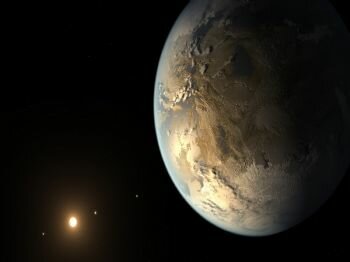
Search for Alien Life Should Target Water, Oxygen and Chlorophyll

Future space telescopes hunting for signs of alien life should focus on water, oxygen and chlorophyll-like pigments, in that order, researchers said.
Search for Alien Life Should Target Water, Oxygen and Chlorophyll
The next generation of space telescopes hunting for signs of extraterrestrial life should focus on water, then oxygen and then alien versions of the plant chemical chlorophyll, a new study suggests.
In the past 20 years or so, astronomers have confirmed the existence of nearly 2,000 worlds outside Earth's solar system. Many of these exoplanets lie in the habitable zones of stars, areas potentially warm enough for the worlds to harbor liquid water on their surfaces. Astrobiologists hope that life may someday be spotted on such alien planets, since there is life pretty much everywhere water exists on Earth.
One strategy to discover signs of such alien life involves looking for ways that organisms might change a world's appearance. For example, chemicals typically shape what are known as the spectra seen from planets by adding or removing wavelengths of light. Alien-hunting telescopes could look for spectra that reveal chemicals associated with life. In other words, these searches would focus on biosignatures — chemicals or combinations of chemicals that life could produce, but that processes other than life could not or would be unlikely to create. [5 Bold Claims of Alien Life]
Do you believe alien life exists elsewhere in the universe? View Results Share This Return To Poll Share This
Astrophysicists Timothy Brandt and David Spiegel at the Institute for Advanced Study in Princeton, New Jersey, sought to see how challenging it might be to conclusively identify signatures of water, oxygen and chlorophyll — the green pigment that plants use to convert sunlight to energy — on a distant twin of Earth using a future off-Earth instrument such as NASA's proposed Advanced Technology Large-Aperture Space Telescope (ATLAST).
The scientists found that water would be the easiest to detect.
"Water is a very common molecule, and I think a mission to take spectra of exoplanets should certainly look for water," said Brandt, the lead study author. "Indeed, we have found water in a few gas giants more massive than Jupiter orbiting other stars."
In comparison, oxygen is more difficult to detect than previously thought, requiring scientific instruments approximately twice as sensitive as those needed to detect water and significantly better at discriminating between similar colors of light.
"Oxygen, however, has only been a large part of Earth's atmosphere for a few hundred million years," Brandt said. "If we see it in an exoplanet, it probably points to life, but not finding oxygen certainly does not mean that the planet is sterile."
Although a well-designed space telescope could detect water and oxygen on a nearby Earth twin, the astrophysicists found the instrument would need to be significantly more sensitive, or very lucky, to see chlorophyll. Identifying this chemical typically requires scientific instruments about six times more sensitive than those needed for oxygen. Chlorophyll becomes as detectable as oxygen only when an exoplanet has a lot of vegetation and/or little in the way of cloud cover, researchers said.
Chlorophyll slightly reddens the light from Earth. If extraterrestrial life does convert sunlight to energy as plants do, scientists expect that the alien process might use a different pigment than chlorophyll. But alien photosynthesis could also slightly redden planets, just as chlorophyll does.
"Light comes in packets called photons, and only photons with at least a certain amount of energy are useful for photosynthesis," Brandt said. Chlorophyll reflects photons that are too red and low in energy to be used for photosynthesis, and it may be reasonable to assume that extraterrestrial pigments would do the same thing, Brandt noted.
The researchers suggest a strategy for discovering Earthlike alien life that first looks for water, then oxygen on the more favorable planets and finally chlorophyll on only the most exceptionally promising worlds.
"The goal of a future space telescope will be primarily to detect water and oxygen on a planet around a nearby star," Brandt said. "The construction and launch of such a telescope will probably cost at least $10 billion and won't happen for at least 20 years — a lot of technology development needs to happen first — but it could be the most exciting mission of my lifetime."
Brandt and Spiegel detailed their findings online Sept. 1 in the journal Proceedings of the National Academy of Sciences.
...
Source : space.com
Comments
Related Posts
- Omics Explorer 3.1 for Mac
- Total Partners with SGI to Upgrade its Pangea Supercomputer
- Aurora-viewers Worldwide Compare Sightings, Provide Real-time Alerts
- Simulating Biofilm Mechanical Behavior Aids Blood Clotting Studies
- Photoacoustic Method allows Rapid Imaging of Living Brain Functions
Recent Posts
- How to add new words to iOS dictionary
- Touch ID patents reveal how Apple uses 'Secure Enclave' in iPhone 5s' A7 chip for fingerprint sensor
- WiFi 's data-free risks for terrorists and criminals
- Mobile phone on planes
- To extend the battery life on your iPhone, iPad and Android
- Google Glass Development Kit (GDK)
- Back Up data on Android Smartphone
- What is Google Glass?
- WhatsApp iOS 7 update of fancy design on German YouTube channel
- Jury's decision 290 million dollar fine about the patent litigation between Samsung and Apple
- A New Application; SNAPCHAT is Wanted to Buy BY GOOGLE AND FACEBOOK
- Apple Buys Action Sensor Maker PrimeSense
- November 25th International Day for the Elimination of Violence Against Women
- Potato Power Could Light the World But How??
- Could be doomsday for Giants
- About Us
- Authors
- Contact
- Privacy Policy
- RSS
- | @ Women Citizen
